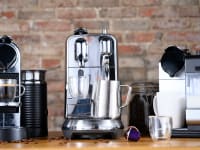Here’s how to make the perfect shot of espresso at home
Elevate your morning coffee experience.
Products are chosen independently by our editors. Purchases made through our links may earn us a commission.
If your recent purchases include an espresso machine, chances are, you’ve been wondering about how to make the most out of this investment. The good news is, espresso machines can be easy to decipher once you learn the basics.
As a latte drinker, I’ve owned and tested a number machines of various price points over the years, like our favorite Breville Barista Touch (available at Amazon). Through trial and error, as well as taking an online espresso class, I’ve gotten the hang of pulling a decent shot of espresso, regardless of the model. Though a good pull requires practice, I believe anyone can become a home barista.
If you’re looking for the best tips and tricks, here’s the most detailed tutorial on how to make espresso at home.
What you should know about espresso machines

If you're trying to kick your Starbucks habit, you may benefit from an espresso machine.
Venturing into the world of espresso machines is like learning a new language. To help you get started and choose an espresso machine that’s best catered to your needs, here are some things to know about brewing espresso.
The key to getting the perfect shot is to first dial-in the machine. Dialing in refers to modifying the dial on the side of the grinder until the barista has the right grind setting to the right brewing time and brewing ratio, controlling the ultimate taste of the coffee. As different beans will carry different density and oiliness, baristas have to constantly re-dial in machines to make sure the coffee has been appropriately extracted. This is the first thing we looked for when testing each machine, and it’s important to understand as you begin making espresso.
A portafilter is a spoon-like device that houses the coffee grounds and attaches to the group head (brewing head) while the brewing process takes place. It has a handle, a spout, a filter basket, and a spring clip. Typically, an espresso machine offers two sizes of filter baskets. The single-walled baskets are for experienced users, who are more comfortable with creating espresso shots based on personal preferences. To securely attach the portafilter to the brewing head, insert the notches (on the edge of the filter) under the grouphead and give it a slight twist.
A tamper is a small tool that helps users press down the coffee grounds to make a flat surface. Most espresso machines come with a tamper.
How to make espresso at home

Here's the most thoroughly explained guide to pulling the perfect shot of espresso.
What You'll Need:
- A burr grinder, like our favorite, Baratza Encore
- A scale, like our favorite coffee scale, Bonavita
-
Coffee beans
- A tamper
- A set of two demitasse glasses (optional)
Time Needed
25 minutes
Difficulty
Easy
Step-by-Step:
Step 1: Prep the beans
The recommended amount of beans used in a double shot is between 18 and 21 grams—we recommend using a kitchen scale to start. Place your portafilter on the scale and tare the weight. Then, weigh 18 to 21 grams of coffee beans on the scale. Run the coffee grinder for a few seconds to make sure it’s free of previously ground coffee.
Step 2: Grind the beans
Finely grind the beans into the filter basket. If the first shot of espresso doesn’t produce the desired flavor, you may need to adjust the coarseness of the grounds later. (This process is called “dialing-in.")
Step 3: Distribute and tamp
Position your index and middle finger in a V-shape above the basket. Slowly rotate the basket as you gently distribute the coffee grounds to make sure the surface is flat and even. Then, hold the portafilter with your non-dominant hand and place the basket on a flat surface (this will be your tamping station). Grab the tamper with your dominant hand and press down firmly, but avoid putting all your weight on it. Twist the tamper a little to give the grounds surface a smooth finish.
Step 4: Prep the machine
Rinse (or “purge” in the coffee world) the group head for 10 seconds with hot steam. Preheat the demitasse glasses by filling with hot water, then discard water.
Step 5: Lock the portafilter in the machine
Insert the portafilter under the group head and then give it a twist to make sure it’s locked in tightly.
Step 6: Run the machine
Place the demitasse glasses under the portafilter. Turn the machine on and wait for the delicious coffee to slowly flow out. Ideally, a double shot of good espresso takes just under 30 seconds to extract.
Step 7: Swirl and taste!
Swirl (some people suggest stirring with a teaspoon) and taste the espresso. There are two scenarios that may require you to adjust the grind size: If the espresso is too sour, this means the grind isn’t fine enough and you may need to dial down the grind size a bit; if it’s too bitter, then you need to dial up the size of the grind.
Some connoisseurs suggest using exclusively espresso beans—and that has some validity to it. Espresso beans are typically medium to dark roasts that can produce optimal extraction under high pressure. However, if your local shop doesn’t differentiate espresso beans from regular coffee beans, just be sure to steer clear of light roasts—they may not carry enough oil for a decent extraction of quality espresso.
If you love the flavor of espresso but don’t feel like committing to a giant machine, you may benefit from owning a moka pot, which is a tea kettle-sized gadget used for making stove-top espresso.
You’re on your way to becoming a kitchen master. Take the next step and sign up for Chef's Course. You’ll get weekly tips, tricks, and recipes from top chefs sent straight to your inbox. It’s a whole master course for free.


